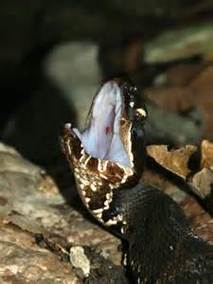Cottonmouth (Water moccasin)Agkistrodon piscivorus |

Custom Search
|
|
The Cottonmouth (Agkistrodon piscivorus) is a venomous snake found in the southeastern United States. The species is North America’s only venomous aquatic snake, the only semi-aquatic pit viper species and is the largest snake of the genus Agkistrodon.
The 3 sub-species of cottonmouths are found in southeast Virginia, south through the Florida peninsula and west to Arkansas in eastern and southern Oklahoma, east and central Texas and west and south Georgia. Some populations of cottonmouths have also been observed on the offshore islands off both the Atlantic and Gulf coasts. The species scientific name derives from the Greek words ancistro (hooked) and odon (tooth), and from the Latin piscis (fish) and voro (to eat), that translates basically into “hooked-tooth fish-eater”. The species common names include many variants like the water moccasin, black moccasin, swamp moccasin, gapper, or simply viper. These common names often refer to the snake's characteristic threat display, where they will often stand their ground and exposing the white interior of the mouth and gape at the perceived threat.

The adult cottonmouths often reach more than 80 cm (31.5 inches) in length, females are smaller than males. But occasionally, some specimens may reach 180 cm (71 inches) or more in length and weight 10 lbs, especially in the eastern parts of their range.
The cottonmouth has a broad triangular-shaped head much wider than its neck a typical look in vipers.Their colouration is highly variable and the patterns on adult cottonmouths often become somewhat obscured, resulting in an almost totally solid dark brown to blackish color. The snake's underbelly is a paler shade and with yellow-brown blotches. Whereas the juvenile cottonmouths have a more brightly colored pattern with very distinctive markings. The body is a brown base color with red to brown bands with an hourglass shape, the tip of the tail is yellow and used to caudal luring. Their aggressiveness has been greatly exaggerated, they prefer to escape most of the time. But if it feels threatened, the cottonmouth engages in a very characteristic threat display into an S-shape with its head back and the mouth open to display the white interior often making a loud hiss and vibrate the tail. Their common names like "cottonmouth" and "gapper" refer specifically to this unique behavior. Some other defensive moves also include flattening the body and emitting a very strong, pungent anal secretion. Subspecies There are 3 subspecies currently recognized, but they differ both in their range and also in skin pattern. Florida cottonmouth (A. p. conanti) - Found in the USA, in extreme southern Georgia and almost all of Florida, including many islands off the coast. Western cottonmouth (A. p. leucostoma) - Found in the US up north in Oklahoma, Illinois, Missouri and Indiana, and south from Alabama along the Gulf of Mexico's coast, including many coastal islands into southeastern and central Texas. Eastern cottonmouth (A. p. piscivorus) - Found also only in the United States across Georgia and northeast to North and South Carolina in the Atlantic Coast including peninsulas and coastal islands. Venom / Bite The cottonmouth as a powerful cytotoxic venom that destroys tissue and is considered more toxic than that of the Copperhead (A. contortrix). The bite symptoms commonly include severe pain, ecchymosis, and swelling, and even though deaths are rare, the cottonmouth bite could leave scars and on occasion lead to amputation. Diet / Feeding The cottonmouth is an ambush predator and the majority of its diet consists of fish and frogs. But the cottonmouth diet also includes mammals, birds, other snakes, cicadas, caterpillars, land snails, small turtles and even small American alligators. Cannibalism has also been reported and the species will sometimes eat carrion. The juvenile specimens feed on invertebrates on occasion and like the copperheads or young jararacas, young cottonmouths use their bright tails to lure prey like amphibians.When catfish are caught and eaten, their sharp spines sometimes cause injuries. Reproduction The males will typically fight one another on ritualized combats for the right to mate with the females. The cottonmouth snake mates in the spring every 2-3 years, and the gestation period lasts 3 to 4 months. The young are born in August or September and have an average length of 8 to 14 inches (22–35 cm).The cottonmouth is ovoviviparous, and females give birth from 1 to 16 live young or even as many as 20. However, the average litter size is around 6 to 8 hatchlings. Females are reported to sometimes defend their newly born litters. Conservation / Threats The cottonmouth is classified as Least Concern species on the IUCN Red List, due to the snake's wide distribution and presumed large population. When it was last assessed in 2007, the population trend was stable. But drainage of wetland habitat for development and the persecution of the species has taken its toll on their population. Despite this, the cottonmouth remains a fairly common species in many areas. The cottonmouth is listed as an endangered species in Indiana.
|
Did You Know?
Capable of slithering at speeds up to 20km/h the deadly black mamba is the world’s fastest snake. Scientific classification |
© 2014 Snake Facts About Us | Privacy Policy | Contact




